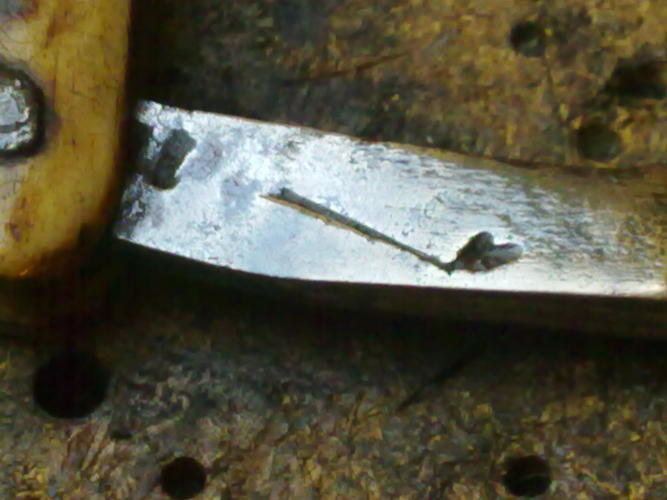Results 1 to 10 of 14
Thread: To whom does this pipe belong?
Hybrid View
-
11-23-2011, 10:31 PM #1
 To whom does this pipe belong?
To whom does this pipe belong?
Good morning gents,
I have just got this little (4/8) razor, I thought it was a Wosty when I bought it but now I'm getting uncertain about its paternity... I just buffed it a little to get away the dirt and the pipe I saw is quite strange... It makes me thing of an old Johnson's mark... does anybody have more info about this mark?
Thanks!
-
11-23-2011, 11:11 PM #2

Someone else asked about the same mark, or very close to it recently. IIRC manah posted that it is G.Johnson ..... I could be wrong though ... I was wrong once before.
Be careful how you treat people on your way up, you may meet them again on your way back down.
-
11-24-2011, 12:22 AM #3

So, it's not G. Johnson's mark. I couldn't find a dart near the pipe.

And it's not a Wostenholm razor, it's not his pipe.
And now. I'll try to tell my idea.
I believe the razor was made by William and John Birks.
It was a very old Sheffield company. The founder was William Birks, who became Master Cutler in 1766. At the beginning it was Birks, Withers & Sykes. It was one of the first enterprises to register a silver mark in 1773. It has a complicated genealogy, because it involved three notable families, several Master Cutlers, and partnerships that became intertwined. The original partners were William Birks (Master Cutler , 1766); Benjamin Withers (Master Cutler, 1756); John Sykes and Dennis Sykes. The address was variously given as Pincin Lane or Pinston Croft Lane - thoroughfares that now correspond to Pinstone Street.
Birks, Withers & Sykes was dissolved in 1780. William Birks & Son then registered a silver mark in 1781 in Norfolk Street. When William Birks died in 1783, aged 55, control passed to his sons - William Birks (Master Cutler, 1795) and John Birks. Henceforth, the Birks' operated alone as manufacturers of table knives and razors until about 1817 (with a pipe device and "Fabre" mark).
So. It was a short history of the company.
And as I could understand, "pipe" mark wasn't used after.
Here the mark on your razor and William and John Birks mark:

After all, is it possible to see picture of all razor?
I want to see the razor, that was made in the early 1800s.
P.S. Of course, I can be wrong. Alex Ts.
Alex Ts.
-
-
11-24-2011, 01:44 AM #4Senior Member



- Join Date
- Apr 2008
- Location
- Essex, UK
- Posts
- 3,816
Thanked: 3164
I think you are absolutely right, Alex - the pipe itself is quite distinctive. It also shows that a distinct lineage of tang shapes cannot be used to directly a date a razor within so many decades.
Regards,
Neil
-
The Following User Says Thank You to Neil Miller For This Useful Post:
manah (11-24-2011)
-
11-24-2011, 11:28 AM #5

Thank you for your precious work, Manah.
I watched closely at your pics and at the mark on this little razor (it's 13 cm. from the toe to the heel), and It doesn't seem to me that it is the same mark. As you can see from this picture, the pipe is more similar to the one of Wostenholm than to the Birks' one in the funnel, but the other part is straight as in the Birks'. Except that the end of it is not square like theirs. I cleaned it a little more with dremel and buffing point.

Also there is this other mark, which really are two marks, that are incomprehensibly under the scales and can be seen only if you open the razor at a certain angle. I think that they are just rust heavy pitting, but who knows...Last edited by Mauri; 11-24-2011 at 12:16 PM.
-
11-24-2011, 12:47 PM #6

Ok. Can we see the picture of all blade/razor?
To know, about what time period we're talking.Alex Ts.
-
11-29-2011, 02:50 AM #7

What if it's really a Golf Club! Who was making razors and playing the Golf in Scotland back then?? It opens up a whole new avenue of inquire!!


 8Likes
8Likes LinkBack URL
LinkBack URL About LinkBacks
About LinkBacks






 Reply With Quote
Reply With Quote
